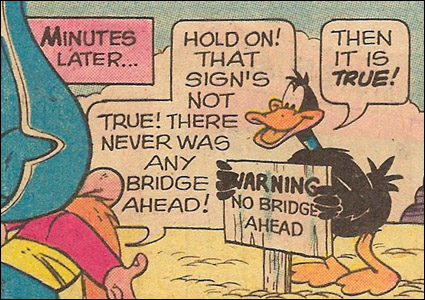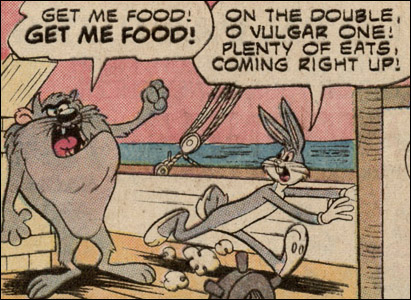
Here's something I've never seen discussed in print about comic books or heard mentioned at conventions. Perhaps it has and I've missed it. Before I bring it up here, let's clarify some terms. A single, usually-rectangular image on a comic book page that contains a moment in the story is called a panel and the lines which go around the panel are called the panel borders. The words like "Later…" or "Meanwhile…" that denote a passage of time, a change of location or some information not conveyed through the drawing or dialogue are called captions. The dialogue is in a container that is called a word balloon. And the space between the panels or between the panels and the edge of the page is called the gutter.
Everyone got the terminology straight? Okay, let's proceed…
There is a theory that has been occasionally followed in comics that word balloons should not touch panel borders; that the balloon should be floated away from them so that color can surround the balloon and you don't have the white of the word balloon meeting the white of the gutters. This makes for better coloring because the colorist isn't always dealing with this big blob of white that is found in almost every panel.
Floating word balloons away from panel borders is sometimes easier if the word balloons are rectangular — or rectangular with rounded corners — as in this panel from a Yosemite Sam comic book published by Gold Key in the mid-seventies…

See? The word balloons do not touch the panel borders as they do in a panel like this from a Bugs Bunny comic book published around the same time…

I think the second works better than the first. The lettering in the first is more intrusive and it's also too large. Also, the idea of balloons not touching panels was to enable the white of the word balloon to be surrounded by color and the colorist of this first panel didn't do that. Furthermore, I think the non-rectangular balloons in the second example just feel more organic. (Full Disclosure: The Bugs Bunny panel is from a story I wrote but I had nothing to do with the lettering or its placement or any of the issues discussed in this article.)
Now, some of you might be wondering why one Gold Key comic book based on characters from Warner Brothers cartoons had a rule against word balloons touching panel borders while another, concurrent Gold Key comic book based on characters from Warner Brothers cartoons didn't. Well, let me amend that: If you're like me, fascinated by all the minutiae of comic book creation and production, you might be wondering. If you're not, skip all the subsequent articles in what will be a series of posts here over the next week or so.
But there is a reason. Lately, there seems to be an increased interest in Gold Key Comics among the kind of folks who are interested in comic book history. At least, I'm getting more questions about that company for which I once worked. I will be telling a few little stories about that line of comics and Part Two will be along in a day or two…or three. Whenever I get to it. And we'll further discuss word balloons touching panel borders.